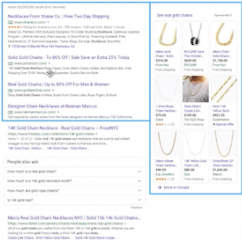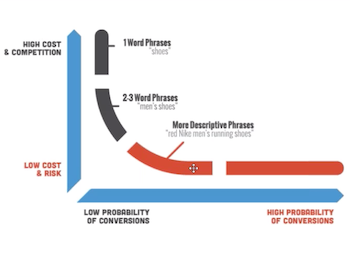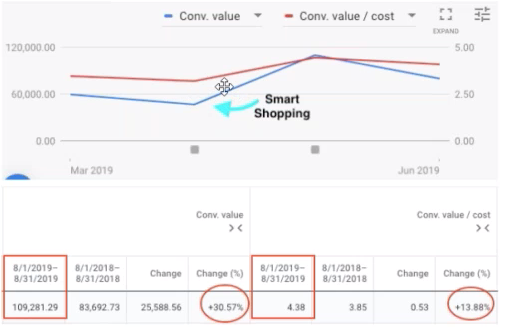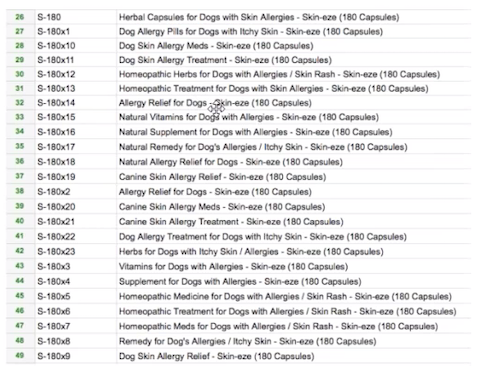Articles and News
How To Acquire An Online Customer Base Using Google, Part II | October 12, 2020 (0 comments)

Atlanta, GA—Consumers might still be buying in stores but they’re shopping online. With rare exception, consumers research online before setting foot in a store and the starting point for their research is Google. Jewelers that want to build their customer base by turning those searchers into customers need to make sure they’re in the top-ranked search results on Google. Image, Visiture: The upper left quadrant is where paid search ads are shown on Google; the upper right is Google Shopping. Organic search results begin below the paid search box.
In a special Centurion webinar, Ron Dod of the digital marketing agency Visiture gave some key tips for jewelers to use to boost their rankings on Google. There are two main methods for doing this: organic (i.e. free) and paid search, where the amount you pay for your advertising is directly determined by how many people click on your listing. In Part I of this series, we discussed using Google organically with search-engine optimization (SEO). This article addresses the other option, using paid search effectively.
Paid search (called pay-per-click/PPC or paid media) garners a low percentage of total Google search traffic—only about 2%—but it results in about 10-15% of a brand’s online revenue, says Dod. That’s because of the four kinds of online searches—informational, navigational, commercial, transactional—it’s focusing solely on #4, transactional.
“With PPC you don’t want to waste money on the first three. When you waste money on short general keyword phrases like “online jewelry shops,” this is how people end up saying ‘Google doesn’t work for me,’” says Dod.
“You want to buy really intentful keyword phrases where someone is ready to buy from you. A short, broad keyword phrase like ‘jewelry’ has a high cost and a low probability of conversion. A phrase like ‘best engagement ring that’s affordable’ has a much higher probability of conversion, so it costs a lot less in terms of return on advertising spend (ROAS),” he explained. If you spend $10,000 a month and have a 4:1 ROAS, that’s $40,000 in sales it’s generating for you. You’re targeting the people who already know what they want and are ready to buy. Those are the ones much more likely to convert.

The more specific the keyword phrase, the more likely it is to attract a customer who's ready to buy and convert to a sale. Chart: Visiture
PPC is one of Google’s two paid options. The other is Google Shopping, which Dod says is the far more effective and drives 85% of search engine marketing and paid media advertising.
“If you’re running Google Ads and not doing Shopping, you should get into it immediately,” he says. And if you want to get into paid search for the first time, he advises to just go straight to Google Shopping.
“When you connect your product feed to Google Merchant Center and Google Ads, Google does all the work for you. They decide, based on how much budget you give them and how much you want to make on whatever budget you give, what’s best for you to hit those goals automatically using algorithms.” You decide how much you’re going to spend and how much you’re going to make, and Google is going to try to return that for you, he says.

Ron Dod of Visiture
Dod cautions both patience and common sense, though. First, it’s not immediate. It will take time for Google’s algorithm to get to where you need to be, but it’s easy to do. Google Merchant Center can take all your product titles and images and decide what keywords to use for your products when people are searching. It even throws in some free listings if there’s low competition in that area.
“This is an actual jeweler and the moment we added Shopping. You can see where their ROAS jumped immediately. It gave them a positive lift of about 37.5% over what they were doing with their old manual campaign.”

Chart: Visiture
And be realistic, Dod said. “Don’t go in there expecting to win 10:1 money. That’s not going to happen, probably, unless you have incredible products or something. That’s a very rare case.
“I highly recommend you look at ROAS as a way to earn a customer, and look at that customer’s lifetime value,” he said. ROAS is important but make sure you don’t put it so high that you choke off your sales and you’re unable to grow. Repeat buyers allow you to grow your business.
Good descriptions, negative keywords, and more. If your site has product titles and descriptions from manufacturers that are not well done, re-do them, says Dod. Use brand names, product numbers, and anything else people would be searching for. This is a more advanced step—which you might want to consult a professional for some guidance—but he also suggests including variable descriptions of the exact same product to capture different ways people might search. For example, all these descriptions are for the same herbal capsules for dogs, but they’ll show up in a variety of different keyword phrases, so apply the same logic to jewelry:

Chart: Visiture
It’s also important to use negative keywords. Dod explains that means you won’tshow up in searches using those keywords. For example, if you’re high-end, you don’t want to pay to show up for people searching for cheap jewelry. So you could use “cheap,” “affordable,” “budget,” etc. as negative keywords so that you don’t come up in those searches.
“When you’re buying keyword phrases, Google tells you what you’re buying, so if you go on your “search phrases” list, you can see what keyword phrases are in there, and if you see you’re wasting $10,000 a year on something like “cheap jewelry,” that’s something you want to put as a negative. If it produces zero sales, you want to negative that keyword phrase in any campaign you have.”
The third ingredient to successful online customer building is retargeting. Simply put, this means that if someone has done a search but doesn’t buy, hit them again with another ad.
“Realize that only 2%-3% of customers actually convert on their first-time visit. Something you should absolutely do is retargeting. Retargeting, also called remarketing, is very simple. Using the Google display network, YouTube, and you also can use Facebook and other media, any time someone comes to a category, product, or order pagem you can feed them ads that are very specific to what they were searching before to get them to come back to buy.
“Google leaves cookies in people’s browsers once they visit, so you can target them with ads to buy at a later point when they’re ready. You can be very specific so if they come back to look at a product they weren’t ready to buy, it’s there. If you’re going to do any ads or SEO it makes sense to do retargeting,” says Dod.
Finally, Dod returns to something he addressed in the beginning of his presentation: the importance of having a good user experience on your site, just like in a store.
“You could have the world’s best paid advertising campaign or products but if your user experience isn’t good, you’re not going to win in Google. Google is not going to place your search results [up high], and your paid media campaigns will not result in converted customers. Look at your competitors and realize that if they have a better price, better reviews, or a better site than you, you’re going to lose. You’re not going to convert that customer. So just be honest with yourself: do you have the best pricing, best call to action, free shipping, the best customer experience? Be candid with yourself. There are so many things you can do to improve that customer experience—free shipping, free pickup, accept a lot of credit cards, etc. Even things like having samples, having people try products before they buy.”
A lot of basic good merchandising strategies can make your Google ads go farther, says Dod.
“Google knows a lot about consumer behavior. Any time you arrive at a site and immediately click the back arrow, Google thinks it didn’t do a good job sending you where you want to go, and that the site isn’t providing a good experience, so it will rank something else higher,” explains Dod.
Apart from good merchandising strategies, optimal speed is a 1.67-second load time for a top rank in Google. While speed itself isn’t a ranking factor, a slow-loading site likely will send an impatient customer straight to the back arrow—signifying a poor customer experience, which it will punish.
Once on your site, make good use of your navigation bar, says Dod. 80% of backlinks will go to your homepage—which Google uses to determine the value of your site. In general, if a customer gets to a site and doesn’t click the arrow back to Google, it thinks, “we did a good job sending this customer here to find what he wanted.” It will then value that site more and raise it up in rankings.
“If you want to win on Google, you have to have a good user experience. You need to really refine that.”







